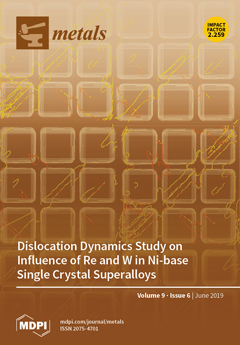The transient evolution of inclusions during Al and Ti additions in a Fe-20 mass pct Cr alloy was investigated using polished cross sections and electrolytic extraction. After Al addition, the evolution of Al
2O
3-based inclusions based upon the area and
[...] Read more.
The transient evolution of inclusions during Al and Ti additions in a Fe-20 mass pct Cr alloy was investigated using polished cross sections and electrolytic extraction. After Al addition, the evolution of Al
2O
3-based inclusions based upon the area and particle size passed through the following three main stages with time: Particle agglomeration, inclusion floating, and a slow decrease of the remaining Al
2O
3-based inclusions. Titanium wire was fed into the steel at the end of the floating stage after Al addition when the Ostwald ripening process was finished. Immediately after Ti addition, the transient phase of Ti oxide was readily generated on the existing Al
2O
3-based inclusion and disappeared due to Al reduction as time progressed. The formation of the transient TiO
x phase was affected by the low disregistry between Al
2O
3 and TiO
x and the local Ti supersaturation, which cannot be predicted by the equilibrium relations of Ti–O–N or Ti–Al–O in the high-Cr-containing melt. Because of the local supersaturation of dissolved [%Ti] and [%N] shortly after Ti addition, TiN associated with existing inclusions and three types of individual TiN including single cubes, twinned inclusions, and clusters were identified. In order to minimize the Ti loss caused by the formation of Ti-rich zones during the transient stages, the removal of large Al
2O
3-based particles including aggregates, clusters, and flower-shaped inclusions should be promoted by stirring before Ti addition. After Ti addition, Brownian and turbulent were the major factors affecting the collision of particles smaller than the threshold of 2.7 μm. The agglomeration of inclusions larger than this threshold was mainly dominated by turbulent and Stokes’ collisions.
Full article





